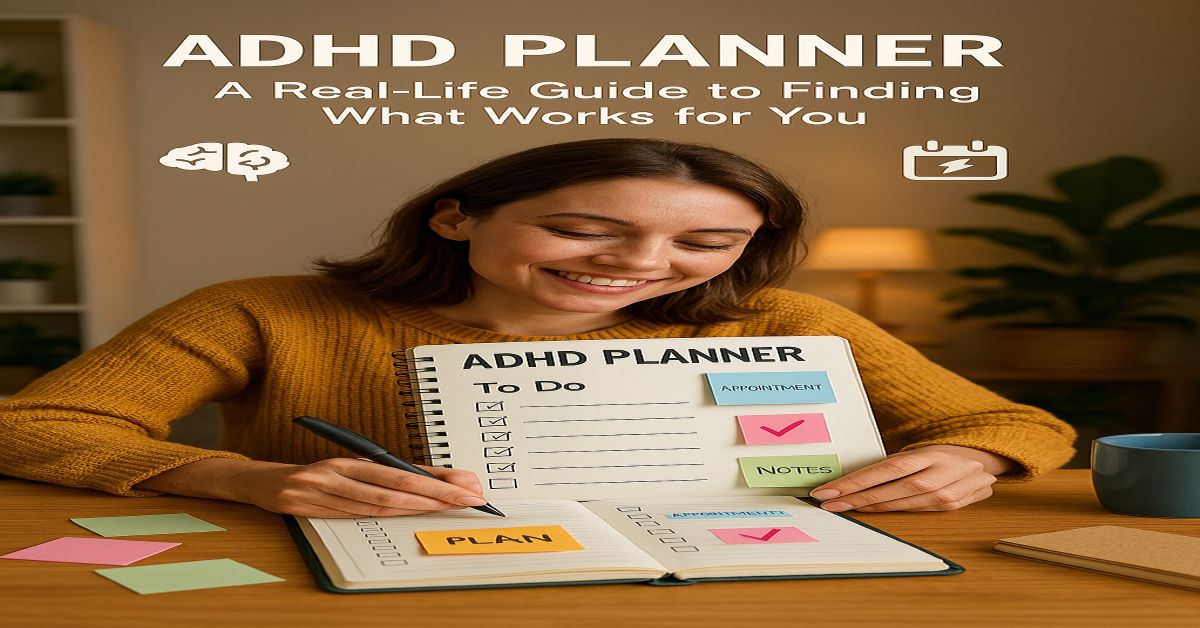If you live with ADHD, you probably know the frustration of trying to stay organized. For many, simply writing things down in a planner feels impossible to stick with. And yet, the right system can be life-changing. An ADHD planner is not one-size-fits-all—it’s a custom approach that works with your brain, not against it.
This guide explores how to find, use, and adapt an ADHD planner so you can create a structure that supports your goals and minimizes stress.
Why Planners Are Different for ADHD Brains
The ADHD brain processes information differently. Focus, memory, and prioritization can be inconsistent, which means traditional planners don’t always work. ADHD-friendly planners must simplify planning, encourage consistency, and offer room for flexibility.
What Makes a Good ADHD Planner?
A good planner for someone with ADHD should:
- Be easy to use and update
- Offer both structure and flexibility
- Allow for daily, weekly, and monthly planning
- Include visual cues like color coding or symbols
- Be engaging enough to reduce boredom over time
Paper vs. Digital: Which One Is Better?
There is no universal answer. Here are some pros and cons:
Paper Planners:
- Tangible and satisfying to write in
- No distractions from apps or notifications
- Great for visual learners
Digital Planners:
- Easy to edit and reorganize
- Can include reminders and alerts
- Accessible on multiple devices
Top Features to Look for in an ADHD Planner
- Undated pages (less pressure)
- Daily checklists
- Time blocking
- Habit trackers
- Space for gratitude, reflection, or brain dumps
Table: Comparison of Popular ADHD Planner Tools
| Planner/App | Format | Best For | Key Features |
| Passion Planner | Paper | Goal setting + creativity | Time blocks, mind maps, reflections |
| Notion | Digital | Custom planning | Templates, drag & drop, integration |
| Planner Pad | Paper | Prioritization lovers | Categories, funnel down structure |
| Sunsama | Digital | Daily task focus | Guided setup, integrates with tools |
| Bullet Journal | Paper | Creative flexibility | Totally customizable |
Combining Tools for Success
Many people with ADHD benefit from using multiple tools. For example:
- Google Calendar for scheduling
- Whiteboard for big-picture planning
- Bullet journal for daily focus
- Post-it notes for reminders
This variety helps keep the system interesting and adaptable.
How to Use a Planner When You Have ADHD
Here are some steps to make your planner work for you:
- Start small with 1-2 goals per day
- Use color coding to separate categories
- Set a recurring time to check your planner
- Keep your planner visible at all times
The Role of Accountability Partners
Sometimes, even the best system needs a human boost. Accountability partners can help by:
- Reminding you to check your planner
- Helping you set realistic goals
- Providing encouragement and feedback
Building Habits That Stick
Habit formation takes time. Tips for success:
- Anchor your planning time to an existing routine (e.g., morning coffee)
- Celebrate small wins (checked tasks)
- Don’t punish inconsistency—reset and move forward
Weekly Planning Tips
- Review what worked and didn’t last week
- Set top 3 priorities for the week
- Block time for high-focus tasks
- Leave white space for rest and flexibility
Daily Planning Hacks
- Write tasks the night before
- Use timers (Pomodoro method)
- Break tasks into micro-steps
- Keep it visual—use stickers, doodles, or highlights
Staying Flexible and Avoiding Planner Burnout
Getting bored or overwhelmed by your planner? That’s okay.
- Switch formats when needed
- Give yourself planner breaks
- Let go of perfectionism
Personalization: Why Your System Should Be Yours
What works for someone else may not work for you. Try different layouts, systems, and supports until you build something that feels natural.
- Mix journaling with task lists
- Use visual aids (vision boards, progress charts)
- Adjust monthly or quarterly
Common Challenges and How to Overcome Them
Challenge: Forgetting to check the planner
Solution: Set phone reminders, leave it in sight
Challenge: Getting overwhelmed by tasks
Solution: Prioritize top 3, ignore the rest until later
Challenge: Sticking to one system
Solution: Accept change and rotate formats
ADHD-Friendly Apps That Complement Planners
- Todoist (task management)
- Trello (project visualization)
- Habitica (gamified habit tracker)
- Forest (focus tool)
- Brili (routine builder)
Expert Tips from ADHD Coaches
- Keep it visual and tactile
- Don’t overload your planner with unrealistic goals
- Use rewards as motivation
- Start each day by reviewing the planner
Final Thoughts
An ADHD planner is more than a tool—it’s a self-designed structure that supports your success. With time, trial, and personalization, you can find a system that not only keeps you on track but empowers you to thrive.
If you’ve been struggling with organization, it’s okay. Start small. Experiment. Explore what feels right. And most importantly, be kind to yourself through the process.
Ready to try your own ADHD planner system? Share your setup in the comments or subscribe for more productivity insights!
Frequently Asked Questions (FAQ)
Q1: Can a planner really help with ADHD?
Yes, when paired with habit building, reminders, and flexibility, a planner can greatly reduce stress and improve productivity.
Q2: What’s the best ADHD planner?
The best one is the one you actually use. Try several and mix formats to see what sticks.
Q3: How do I make planning a daily habit?
Start small. Pair it with another habit like brushing your teeth or having coffee. Make it enjoyable.
Q4: What if I stop using my planner?
That’s normal. Restart without guilt. Think of planning as a cycle, not a fixed routine.







